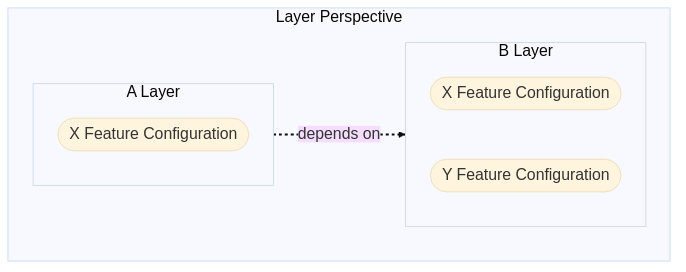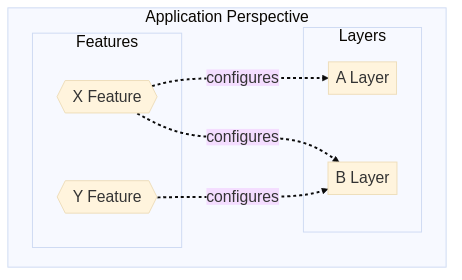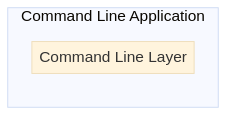Architecture
Gazel's layer and feature system allows you to create any type of software architecture to suit different needs. In this system, layers and features form a matrix which we call an application.
There are three concepts: Application, Layer and Feature;
An Application consists of layers and features. It is designed according to an architectural pattern. For example, Service Application consists of Service Layer, Business Logic Layer and Data Access Layer whereas Api Application consists of Rest Api Layer and Service Client Layer.
A Layer introduces a new framework, library or SDK for an application to have a base to be configured. For example, Data Access Layer introduces NHibernate, IoC Layer introduces Windsor and so on.
A Feature configures one or more layers to make a certain functionality available to your application. For example, the feature Audit Option configures both Service Layer and Data Access Layer, so that it can log service requests as well as it adds audit columns to entities.
Assume we have an application with two layers and two features, below diagram represents this application from layer perspective;

This is an application with two layers A Layer and B Layer, where A Layer
only has a configuration from X Feature, but B Layer has configurations
from both X Feature and Y Feature.
Let's look at the same application from feature perspective;

Here you can see that this is an application with two features; X Feature and
Y Feature with their configurations to relevant layers.
The difference between a layer and a feature is that a layer continue to exist without a configuration from a feature. So it only contains configurations from features. On the other hand, features consist of configurations, without them there won't be any features.
Finally you can see above application from application perspective;

Now that you have learned three basic concepts Application, Layer and Feature, it is time to move on to next section.
Applications
Here we list built-in applications of Gazel. Every application has IoC Layer and Application Layer by default.
- IoC Layer : This layer introduces dependency injection to all applications and base to all other layers.
- Application Layer : This layer manages
IApplicationBuilderinstance and handlesOnStartandOnStopconfigurations.
Service Application
Service application is designed to serve business functionality as internal services. This application is currently the only one that provides a data access layer. Below diagram illustrates a service application architecture;

It consists of three layers;
- Service Layer : This layer gets domain objects from IoC container and exposes your public methods as internal business services.
- Business Logic Layer : This layer scans your module assemblies and registers them to IoC container.
- Data Access Layer : This layer gest persistent classes from IoC container and maps them to a database. This way it enables your application to communicate with an RDBMS.
Features
- Audit
- Authentication
- Authorization
- Cache
- Concurrency Limiter
- Crypto
- Decimal Point
- Exception Handling
- File System
- Hashing
- Localization
- Logging
- Message Queue
- Remote Call
- Secure Call
- Transaction
- Utc
Middleware Application
Middleware Application consists of business modules without a data access layer and exposes configured methods as RESTful endpoints. Below you can see an architectural diagram of this application.

It consists of two layers;
- Rest Api Layer : This layer contains runtime-generated controller classes which converts and forwards incoming messages to business services.
- Service Local Client Layer : This layer serves as an adapter between Rest Api and Business Logic.
- Business Logic Layer : This layer scans your module assemblies and registers them to IoC container.
Just like a service application you can create business modules but this time without a Data Access Layer. This means that within this application, you are expected to consume and orchestrate services from other systems.
Features
- Audit
- Authentication
- Authorization
- Concurrency Limiter
- Crypto
- Decimal Point
- Exception Handling
- File System
- Hashing
- Localization
- Logging
- Secure Call
- Utc
Api Application
Api Application acts as an api gateway and exposes configured internal services to be available publicly via RESTful endpoints. Below you can see architectural diagram of this application.

- Rest Api Layer : This layer contains runtime-generated service classes which converts and forwards incoming messages to service client layer.
- Service Client Layer : This layer accepts incoming messages, converts them to internal HTTP calls and redirects them to business services in a Service Application.
Features
- Authentication
- Concurrency Limiter
- Exception Handling
- Http Header
- File System
- Hashing
- Localization
- Logging
- Secure Call
- Utc
Gateway Application
Gateway Application is designed to serve desktop or single-page web applications that consumes directly internal business services. Unlike Api Application, it does NOT transform HTTP messages between client and service application. It only restricts client application to use a certain subset of internal business services.

- Gateway Layer : This layer contains a ASP.NET Core middleware that forwards requests directly to the backing service application url. It can also restrict a service from consumption.
- Service Client Layer : This layer configures url of backing service application and passes it to gateway layer.
Features
- Application Session
- Authentication
- Concurrency Limiter
- Hashing
- Http Header
- Logging
- Utc
Command Line Application
Command Line Application is designed to easily develop CLIs. Unlike other applications it is not a web application. It only consists of a Command Layer;

- Command Line Layer : This layer scans
application assembly to find implementations of
ICommandinterface and register command routing so that a CLI command is forwarded to theExecutemethod of your command classes.
Features
- Exception Handling
- File System
- Localization
- Logging
Layers
Below is the list of available layers in Gazel. Every layer introduces zero or more configuration interfaces. These configuration interfaces mostly act as wrappers around a new framework or library so that a feature can be built on top of those technologies provided by layers.
Default Layers
IoC Layer and Application Layer are default in all applications, hence it it is better to put them before the rest.
IoC Layer
Gazel uses Castle.Windsor as its dependency injection framework. This layer introduces two configurations:
IComponentModelBuilderConfiguration: ProvidesIComponentModelBuilderinstance. Implement this configuration to add windsor interceptors or to make a change in lifecycles of already registered components.IIoCConfiguration: ProvidesIKernelinstance. Implement this to register new components.IServiceCollectionis available to be resolved so that you can add other ASP.NET Core features.
Every layer configuration has a IKernel parameter for features to be able
to Resolve components. IIoCConfiguration is the only type of
configuration where it is safe to register new components.
Application Layer
This layer serves as a base for every application and exposes three configurations:
IApplicationBuilderConfiguration: ProvidesIApplicationBuilderinstance. Use this configuration when you need to add new features viaUsemethods.IEndpointConfiguration: ProvidesIEndpointRouteBuilderinstance. Use this configuration to register any route to your application.IOnStartConfiguration: This configuration is called right after application building is done. It is a hook onApplicationStartedlifetime event.IOnStopConfiguration: This configuration is called duringApplicationStoppinglifetime event.
Business Logic Layer
Business logic layer scans your module assemblies, registers your classes to IoC container and configures methods to be exposed as business services. Gazel uses Routine to define a coding style. It has two configuration interfaces;
ICodingStyleConfiguration: ProvidesConventionBasedCodingStyleinstance. Use this configuration to introduce new conventions for your the classes in module projects.IInterceptionConfiguration: ProvidesConventionBasedInterceptionConfiguration. Use this configuration to register new interceptors to your business services.
Client Api Layer
Client api layer enables your application to consume other service applications from yours. Gazel uses Routine to generate client api code, This layer introduces one configuration;
IClientApiConfiguration: ProvidesClientApiConfigurerinstance. Use this to configure a client context of your service dependency.
Command Line Layer
Command line layer scans your application assembly to look for implementations
of ICommand interface. Gazel uses CommandLineParser to parse arguments
into command and options. This layer introduces one configuration;
ICommandLineConfiguration: ProvidesParserSettingsinstance. Use this configuration to change the way CommandLineParser behaves.
Data Access Layer
Gazel makes use of Generic Repository Pattern with two interfaces
IRepository<T> and ILookup<T>. With their NHibernate implementations
NHibernateRepository<T> and NHibernateLookup<T>, Gazel enables your module
classes to perform CRUD operations. Fluent NHibernate is used to configure
data access layer by conventions.
To create a new configuration in this layer, there are two configuration interfaces:
IMappingConfiguration: Helps you to have an access toAutoPersistenceModelinstance so that you can create new ORM conventions, or override existing conventions.INHibernateConfiguration: Helps you to have an access toFluentConfigurationinstance so that you can configure other things than class mappings.
For more information see Fluent NHibernate Documentation
Gateway Layer
This layer is created specificaly to make Gateway Application possible. It does not introduce a new library or framework, instead it introduces a custom configuration to enable some changes in gateway behaviour;
IGatewayConfiguration: ProvidesConventionBasedGatewayConfigurationinstance. Use this to change header mappings and/or to allow/forbid some requests.
Rest Api Layer
Gazel uses ASP.NET Core MVC to render controllers out of your business services. It generates source code, compiles and registers it during initalization of your application. It provides below configurations;
IRestApiConfiguration: ProvidesRestApiTemplateinstance. Use this to change action routes, naming conventions and type conversions in generated code.ICodeCompilerConfiguration: ProvidesCodeCompilerinstance. You may use this to add references to the generated rest api assembly. You are also allowed to add custom code to include in compilation.ISwaggerConfiguration: ProvidesSwaggerOptions,SwaggerGenOptionsandSwaggerUIOptionsinstances. Use this options to configure your generated swagger document.
Service Client Layer
Service client layer registers an IClientContext instance to IKernel so
that you can use it to make calls to business services internally. This layer
uses Routine to make client requests to a remote http endpoint. As an
example, Api Application makes use of this layer to consume business services
from a given base URL. It comes with one configuration;
IServiceClientConfiguration: ProvidesConventionBasedServiceClientConfigurationandConventionBasedInterceptionConfigurationinstances. Use this to alter request/response headers and/or intercept business services from client.
Service Layer
Service layer works directly with Business Logic Layer so that your domain objects can be accessed through http endpoints. This layer uses Routine to expose objects as services. It introduces two configuration interfaces:
IServiceConfiguration: Helps you to configure request and response headers of your busines services.IServiceClientConfiguration: ProvidesConventionBasedServiceClientConfigurationandConventionBasedInterceptionConfigurationinstances. Use this to alter request/response headers and/or intercept remote service calls from client.
Service Local Client Layer
This layer registers an IClientContext instance that consumes Business Logic
Layer locally, without an HTTP layer. This layer serves as an adapter between
layers that require IClientContext and layers that provide ICodingStyle,
such as Middleware Application and does not introduce an additional
configuration interface.